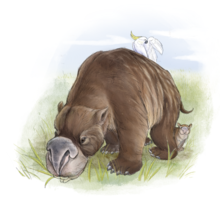
Back ديبروتودون Arabic Diprotodon optatum Catalan Diprotodon Czech Diprotodon German Diprotodon Spanish Diprotodon Basque دیپروتودون Persian Diprotodon Finnish Diprotodon French Diprotodon Irish
| Diprotodon Temporal range: Pleistocene,
| |
|---|---|

| |
| Diprotodon skeleton cast, MNHN, Paris | |

| |
| Illustration of a female Diprotodon with joey and sulphur-crested cockatoo | |
| Scientific classification | |
| Domain: | Eukaryota |
| Kingdom: | Animalia |
| Phylum: | Chordata |
| Class: | Mammalia |
| Infraclass: | Marsupialia |
| Order: | Diprotodontia |
| Family: | †Diprotodontidae |
| Genus: | †Diprotodon |
| Type species | |
| Diprotodon optatum Owen, 1838
| |
| Synonyms[1] | |
| |
Diprotodon (Ancient Greek: "two protruding front teeth") is an extinct genus of marsupial from the Pleistocene of Australia containing one species, D. optatum. The earliest finds date to 1.77 million to 780,000 years ago but most specimens are dated to after 110,000 years ago. Its remains were first unearthed in 1830 in Wellington Caves, New South Wales, and contemporaneous paleontologists guessed they belonged to rhinos, elephants, hippos or dugongs. Diprotodon was formally described by English naturalist Richard Owen in 1838, and was the first named Australian fossil mammal, and led Owen to become the foremost authority of his time on other marsupials and Australian megafauna, which were enigmatic to European science.
Diprotodon is the largest-known marsupial to have ever lived; it greatly exceeds the size of its closest living relatives wombats and koalas. It is a member of the extinct family Diprotodontidae, which includes other large quadrupedal herbivores. It grew as large as 1.8 m (5 ft 11 in) at the shoulders, over 4 m (13 ft) from head to tail, and likely weighed several tonnes, possibly as much as 3,500 kg (7,700 lb). Females were much smaller than males. Diprotodon supported itself on elephant-like legs to travel long distances, and inhabited most of Australia. The digits were weak; most of the weight was probably borne on the wrists and ankles. The hindpaws angled inward at 130°. Its jaws may have produced a strong bite force of 2,300 newtons (520 pounds-force) at the long and ever-growing incisor teeth, and over 11,000 newtons (2,500 lbf) at the last molar. Such powerful jaws would have allowed it to eat vegetation in bulk, crunching and grinding plant materials such as twigs, buds and leaves of woody plants with its bilophodont teeth.
It is the only marsupial and metatherian that is known to have made seasonal migrations. Large herds, usually of females, seem to have marched through a wide range of habitats to find food and water, walking at around 6 km/h (3.7 mph). Diprotodon may have formed polygynous societies, possibly using its powerful incisors to fight for mates or fend off predators, such as the largest-known marsupial carnivore Thylacoleo carnifex. Being a marsupial, the mother may have raised her joey in a pouch on her belly, probably with one of these facing backwards, as in wombats.
Diprotodon went extinct about 40,000 years ago as part of the Late Pleistocene megafauna extinctions, along with every other Australian animal over 100 kg (220 lb); the extinction was possibly caused by extreme drought conditions and predation pressure from the first Aboriginal Australians, who likely co-exised with Diprotodon and other megafauna in Australia for several thousand years prior to its extinction. There is little direct evidence of interactions between Aboriginal Australians and Diprotodon—or most other Australian megafauna. Diprotodon has been conjectured by some authors to have been the origin of some aboriginal mythological figures—most notably the bunyip—and aboriginal rock artworks but these ideas are unconfirmable.
© MMXXIII Rich X Search. We shall prevail. All rights reserved. Rich X Search